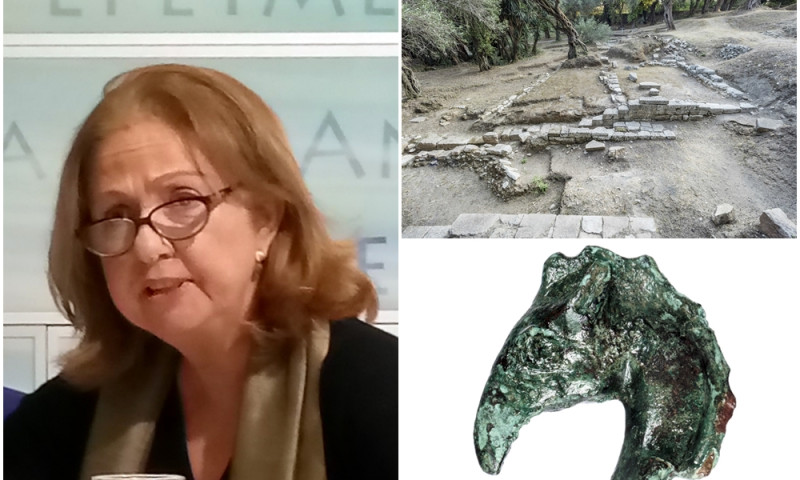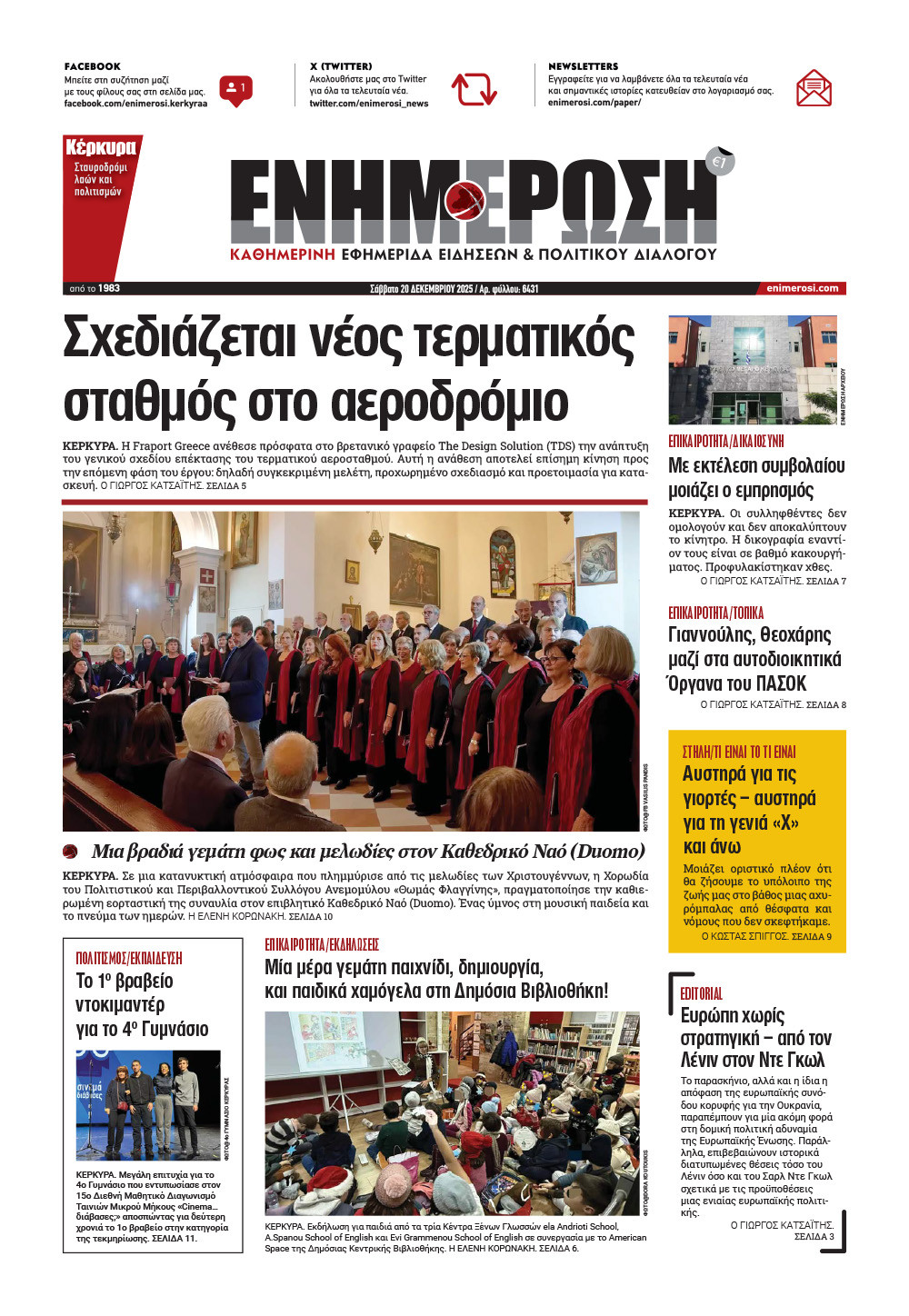What archaeological dig at Mon Repos uncovered

Mon Repos
16 Dec 2019
/ 09:42
CORFU. The findings of the first organised archaeological excavations for 52 years were presented at Corfu Archaeological Museum.
Half a century has passed since the last systematic dig at Mon Repos. On the initiative of Corfu Antiquities Inspectorate, which obtained positive interest from the Leventis Foundation and the businessman Giorgos David, another excavation was conducted. Honorary director at the Ministry of Culture Dr. Metallionou was happy to undertake the work in the summer of 2018.
Dr. Metallinou said that regulations dictate that excavation work cannot be conducted for more than 35 days in a year and so the work was carried out in August 2018 and August 2019. Dr. Metallinou presented the findings at the newly-renovated Archaeological Museum on Saturday.
1576411289.jpg)
1576442540.jpg)
The welcoming address was given by the Director of the Antiquities Inspectorate Tenia Rigakou followed by former Mayor Yiannis Kourkoulos, President of the Friends of Corfu Archaeological Museum Society (40 members), who expressed his disappointment at how little interest the Corfu public appears to have in Corfu's antiquities. "The community takes no part and has its eyes shut," he said.
1576411294.jpg)
Before her presentation on the moveable and static findings, Dr. Metallinou gave a brief historical background to give some perspective to the work done. "The aim of the work is, first of all, to provide a complete picture of the antiquities that are already visible and are in fragmentary condition - which archaeologists believe doesn't help either the research or the ability of visitors to clearly understand the ruins. There are many visitors and they want to be able to get a clear picture of the site and what its purpose was."

According to Dr. Metallinou, many visitors are fascinated by the site and want to feel what it was like in the past. "With this in mind, we made it our first priority to discover the ground plan of the building on the eastern slope of the hill with Hera's sanctuary. We wanted to get a proper picture of the building and what its function was - including its relationship with the sanctuary and temple at the top of the hill, topographically and functionally." For this reason the northern side of the building was further excavated as well as the western side, and a total length of 26.5 metres was revealed.

Two roads were also discovered on the northern and southern sides of the building. As well as in the building, excavations were also carried out on a section of the retaining walls around the temple, which had previously only partially been uncovered. In 2019 excavations were extended to another area to the north of the sanctuary and other antiquities were found there - destroyed layers and the walls of another building.
Dr. Metallinou says that visits to the temple are linked with offerings - either perishable materials such as glass, cloth or wood or objects made of clay, metal or ivory.
Some of the discoveries made were:
- Handmade figurines dated between 610 and 480 BC. These are exclusively female deities and are offerings of a wide range but low quality which can be found in Greece, Cyprus and South Italy.
- Figurines from the Hellenistic period.
- Bronze dedications including decorative griffins. This is a demonic creature from the East which is a cross between a lion and a predatory bird. It represents power but also in the sense of a deterrent - guarding treasure, for example. These were probably decorations on pots - large bronze vessels similar to cauldrons - which stood on tripods as offerings to gods in the 8th and 7th centuries BC.

- Clay loomweights and tool weights.
- Storage vessels with fine glazing and embossed decoration.
- Miniature vessels: It is said that these are small copies of real pottery and vessels and were offered to temples in the 7th century BC - when the right to confer them passed from the aristocracy to simple people. These are, in other words, cheap offerings - but they were produced in increasing numbers as they spread geographically and allowed simple people to take a greater part in ceremonies.
These humble items help us get a clearer understanding of religious practices in ancient Corfu.
- Dedicatory plates
- Spearheads with traces of their wooden shafts.

In addition to the above, a large number of ceramic items were collected which are now being studied.
The excavations will continue for another three years.
Dr. Metallinou said that regulations dictate that excavation work cannot be conducted for more than 35 days in a year and so the work was carried out in August 2018 and August 2019. Dr. Metallinou presented the findings at the newly-renovated Archaeological Museum on Saturday.
1576411289.jpg)
1576442540.jpg)
The welcoming address was given by the Director of the Antiquities Inspectorate Tenia Rigakou followed by former Mayor Yiannis Kourkoulos, President of the Friends of Corfu Archaeological Museum Society (40 members), who expressed his disappointment at how little interest the Corfu public appears to have in Corfu's antiquities. "The community takes no part and has its eyes shut," he said.
1576411294.jpg)
Before her presentation on the moveable and static findings, Dr. Metallinou gave a brief historical background to give some perspective to the work done. "The aim of the work is, first of all, to provide a complete picture of the antiquities that are already visible and are in fragmentary condition - which archaeologists believe doesn't help either the research or the ability of visitors to clearly understand the ruins. There are many visitors and they want to be able to get a clear picture of the site and what its purpose was."

According to Dr. Metallinou, many visitors are fascinated by the site and want to feel what it was like in the past. "With this in mind, we made it our first priority to discover the ground plan of the building on the eastern slope of the hill with Hera's sanctuary. We wanted to get a proper picture of the building and what its function was - including its relationship with the sanctuary and temple at the top of the hill, topographically and functionally." For this reason the northern side of the building was further excavated as well as the western side, and a total length of 26.5 metres was revealed.

Two roads were also discovered on the northern and southern sides of the building. As well as in the building, excavations were also carried out on a section of the retaining walls around the temple, which had previously only partially been uncovered. In 2019 excavations were extended to another area to the north of the sanctuary and other antiquities were found there - destroyed layers and the walls of another building.
Dr. Metallinou says that visits to the temple are linked with offerings - either perishable materials such as glass, cloth or wood or objects made of clay, metal or ivory.
Some of the discoveries made were:
- Handmade figurines dated between 610 and 480 BC. These are exclusively female deities and are offerings of a wide range but low quality which can be found in Greece, Cyprus and South Italy.
- Figurines from the Hellenistic period.
- Bronze dedications including decorative griffins. This is a demonic creature from the East which is a cross between a lion and a predatory bird. It represents power but also in the sense of a deterrent - guarding treasure, for example. These were probably decorations on pots - large bronze vessels similar to cauldrons - which stood on tripods as offerings to gods in the 8th and 7th centuries BC.

- Clay loomweights and tool weights.
- Storage vessels with fine glazing and embossed decoration.
- Miniature vessels: It is said that these are small copies of real pottery and vessels and were offered to temples in the 7th century BC - when the right to confer them passed from the aristocracy to simple people. These are, in other words, cheap offerings - but they were produced in increasing numbers as they spread geographically and allowed simple people to take a greater part in ceremonies.
These humble items help us get a clearer understanding of religious practices in ancient Corfu.
- Dedicatory plates
- Spearheads with traces of their wooden shafts.

In addition to the above, a large number of ceramic items were collected which are now being studied.
The excavations will continue for another three years.












